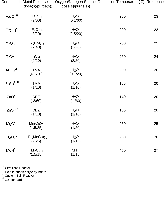Atomic layer deposition of 2D and 3D standards for synchrotron-based quantitative composition and structure analysis methods
Abstract
Atomic layer deposition (ALD) is a scalable deposition technique known for producing uniform, conformal films of a wide range of compounds on nearly any substrate material. These traits make it an ideal deposition method for producing films to replace the National Institute of Standards and Technology (NIST) standards and create Standard Reference Materials (SRMs) on a wide range of relevant two-dimensional and three-dimensional substrates. The use of SRM from NIST for quantitative analysis of chemical composition using synchrotron based x-ray fluorescence (SR-XRF) and scanning transmission x-ray microscopy (STXM) is common. Such standards, however, can suffer from inhomogeneity in chemical composition and thickness and often require further calculations, based on sample mounting and detector geometry, to obtain quantitative results. These inhomogeneities negatively impact the reproducibility of the measurements and the quantitative measure itself. Utilizing Rutherford backscattering, x-ray reflectivity, quartz crystal microbalance, STXM, and SR-XRF, the authors show here that ALD is capable of producing high quality standards that are homogenous over scales ranging from nanometers to 100s of micrometers.
- Authors:
-
- Illinois Inst. of Technology, Chicago, IL (United States). Physics Dept.
- Lawrence Berkeley National Lab. (LBNL), Berkeley, CA (United States)
- European Synchrotron Radiation Facility (ESRF), Grenoble (France)
- Univ. of Chicago, Argonne, IL (United States). GSECARS
- Argonne National Lab. (ANL), Argonne, IL (United States). X-Ray Science Dept. Advanced Photon Source
- Argonne National Lab. (ANL), Argonne, IL (United States). Material Science Division
- Alternative Energies and Atomic Energy Commission (CEA), Saclay (France)
- Publication Date:
- Research Org.:
- Lawrence Berkeley National Lab. (LBNL), Berkeley, CA (United States); Argonne National Lab. (ANL), Argonne, IL (United States); Univ. of Chicago, Argonne, IL (United States)
- Sponsoring Org.:
- USDOE Office of Science (SC), High Energy Physics (HEP); USDOE Office of Science (SC), Basic Energy Sciences (BES); National Science Foundation (NSF)
- OSTI Identifier:
- 1493253
- Alternate Identifier(s):
- OSTI ID: 1422434
- Grant/Contract Number:
- AC02-05CH11231; AC02-06CH11357; FG02-94ER14466; EAR-1634415
- Resource Type:
- Accepted Manuscript
- Journal Name:
- Journal of Vacuum Science and Technology. A, Vacuum, Surfaces and Films
- Additional Journal Information:
- Journal Volume: 36; Journal Issue: 2; Journal ID: ISSN 0734-2101
- Publisher:
- American Vacuum Society
- Country of Publication:
- United States
- Language:
- English
- Subject:
- 74 ATOMIC AND MOLECULAR PHYSICS; synchrotrons; Rutherford backscattering spectroscopy; X-ray microscopy; metal oxides; transition metals; multilayers; X-ray reflectivity; 3D printing; quartz crystal microbalance; atomic layer deposition
Citation Formats
Becker, Nicholas G., Butterworth, Anna L., Salome, Murielle, Sutton, Stephen R., De Andrade, Vincent, Sokolov, Andrey, Westphal, Andrew J., and Proslier, Thomas. Atomic layer deposition of 2D and 3D standards for synchrotron-based quantitative composition and structure analysis methods. United States: N. p., 2018.
Web. doi:10.1116/1.5025240.
Becker, Nicholas G., Butterworth, Anna L., Salome, Murielle, Sutton, Stephen R., De Andrade, Vincent, Sokolov, Andrey, Westphal, Andrew J., & Proslier, Thomas. Atomic layer deposition of 2D and 3D standards for synchrotron-based quantitative composition and structure analysis methods. United States. https://doi.org/10.1116/1.5025240
Becker, Nicholas G., Butterworth, Anna L., Salome, Murielle, Sutton, Stephen R., De Andrade, Vincent, Sokolov, Andrey, Westphal, Andrew J., and Proslier, Thomas. Fri .
"Atomic layer deposition of 2D and 3D standards for synchrotron-based quantitative composition and structure analysis methods". United States. https://doi.org/10.1116/1.5025240. https://www.osti.gov/servlets/purl/1493253.
@article{osti_1493253,
title = {Atomic layer deposition of 2D and 3D standards for synchrotron-based quantitative composition and structure analysis methods},
author = {Becker, Nicholas G. and Butterworth, Anna L. and Salome, Murielle and Sutton, Stephen R. and De Andrade, Vincent and Sokolov, Andrey and Westphal, Andrew J. and Proslier, Thomas},
abstractNote = {Atomic layer deposition (ALD) is a scalable deposition technique known for producing uniform, conformal films of a wide range of compounds on nearly any substrate material. These traits make it an ideal deposition method for producing films to replace the National Institute of Standards and Technology (NIST) standards and create Standard Reference Materials (SRMs) on a wide range of relevant two-dimensional and three-dimensional substrates. The use of SRM from NIST for quantitative analysis of chemical composition using synchrotron based x-ray fluorescence (SR-XRF) and scanning transmission x-ray microscopy (STXM) is common. Such standards, however, can suffer from inhomogeneity in chemical composition and thickness and often require further calculations, based on sample mounting and detector geometry, to obtain quantitative results. These inhomogeneities negatively impact the reproducibility of the measurements and the quantitative measure itself. Utilizing Rutherford backscattering, x-ray reflectivity, quartz crystal microbalance, STXM, and SR-XRF, the authors show here that ALD is capable of producing high quality standards that are homogenous over scales ranging from nanometers to 100s of micrometers.},
doi = {10.1116/1.5025240},
journal = {Journal of Vacuum Science and Technology. A, Vacuum, Surfaces and Films},
number = 2,
volume = 36,
place = {United States},
year = {Fri Feb 23 00:00:00 EST 2018},
month = {Fri Feb 23 00:00:00 EST 2018}
}
Web of Science
Figures / Tables:
 Table 1: Precursor chemistries, dose time, purge time, and deposition temperature for all compounds measured. These parameters are for 2D standards unless otherwise noted.
Table 1: Precursor chemistries, dose time, purge time, and deposition temperature for all compounds measured. These parameters are for 2D standards unless otherwise noted.
Figures / Tables found in this record:

 Search WorldCat to find libraries that may hold this journal
Search WorldCat to find libraries that may hold this journal